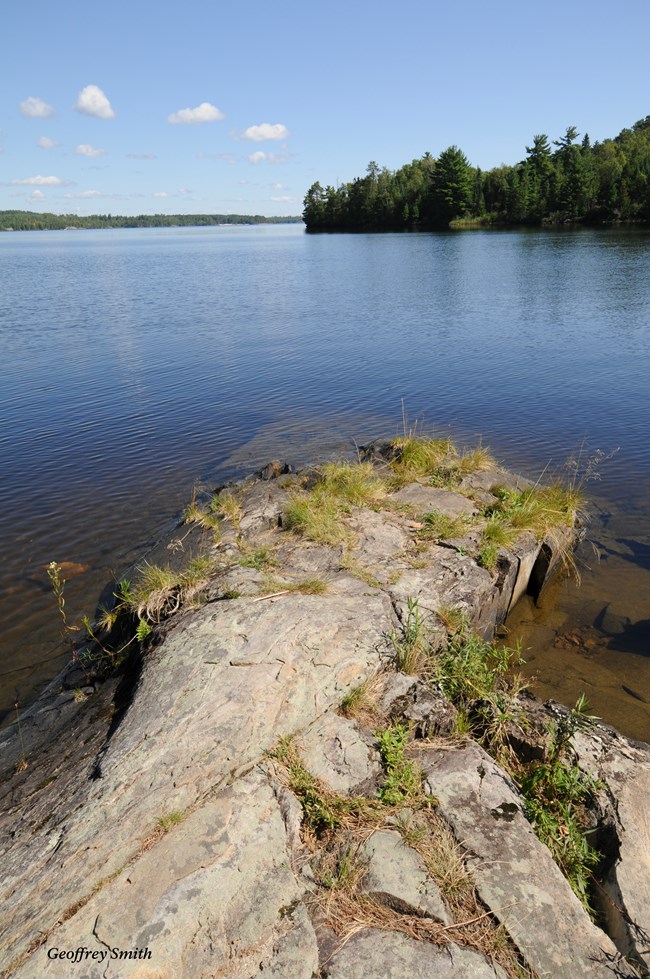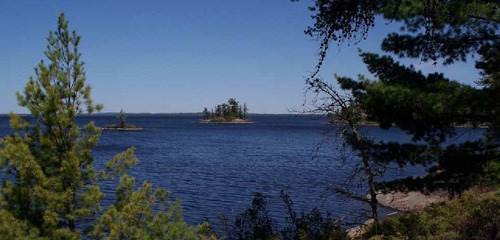
Background Voyageurs National Park (Voyageurs; Figure 1) encompasses part or all of four large lakes and 26 smaller interior lakes, and many of the lakes are home to native coldwater fish including lake trout, lake whitefish, and cisco. Climate scientists predict a 2 - 5 °C (3.6 - 9.0 °F) increase in mean annual temperature by the end of the 21st century for this region, and the surface temperatures of inland lakes in this region are expected to increase by 1 - 7 °C (1.8 - 12.6 °F) during summer. Higher temperatures can affect physiological functions in fish, and as a consequence, coldwater fish populations that are faced with warming conditions may decrease in abundance or fail to persist. Higher temperatures are also expected to be accompanied by lower dissolved oxygen concentrations (oxygen in the water that is available to fish) in most lakes. Therefore, suitable habitat for coldwater fish species is expected to decline. This may lead to the elimination of some populations of these fish, especially along the southern edge of their distribution, an area that includes Voyageurs National Park. Climate Change and Coldwater Fish Species Because coldwater fish species require cold water with sufficient levels of dissolved oxygen (DO), they are especially vulnerable to climate change. In summer, their habitat is frequently restricted to the lower portion of the water columns of lakes, where suitably cold water temperatures are maintained through the open water season. However, oxygen concentrations in those areas decline throughout the summer because decomposition of organic materials that settle into those areas consumes oxygen. Water temperatures in the upper layers of the water column become too warm for coldwater fish during the summer, thus limiting coldwater fish to a specific layer of habitat, where both water temperature and oxygen levels allow their survival (Figure 2). In especially warm years, this habitat may disappear altogether, leading to mortality events in the affected populations (Figure 3)1&2. 
Figure 2. Due to temperature and oxygen requirements of coldwater fish, climate change may restrict available habitat. Increased solar radiation will expand the zone of warm surface water, while metabolic processes will eliminate oxygen in a larger portion near the bottom of the water column in a warmer climate, decreasing habitat suitable for coldwater fish (smaller band of suitable habitat after warming shown in bottom panel). Adapted from Ficke et al. 20071. 
Photo Credit: Peter Jacobson, Minnesota Department of Natural Resources 
Photo Credit: Geoffrey Smith Outlook Studies predict the degradation of coldwater fish habitat due to warmer water temperatures in the upper water column and less oxygen in the deeper water (Figure 4). As a result, it is expected that coldwater fish will be eliminated in many regional lakes but will persist in some lakes that are deep enough to maintain cold, well-oxygenated water—including some lakes along the northern edge of the contiguous United States (e. g. Voyageurs National Park). The dispersal of other fish species in response to a warming climate may also have significant impacts on coldwater fish. As lakes become warmer over the next century, conditions will become favorable to species like smallmouth bass.Smallmouth bass are ferocious predators and can greatly reduce populations of many important prey species available to lake trout. Lake trout must then shift their diet to less energetically efficient prey items, which can negatively impact their growth, reproduction, and survival rates. Coldwater fish species are especially vulnerable in lakes receiving excess nutrients. Temperature increases can enhance the productivity of lakes by increasing nutrient cycling rates, exacerbating the problem of excess nutrients. Increasing temperatures would likely be accompanied by increases in lake productivity, which would further reduce oxygen levels in lakes by increasing the amount of decomposing organic material in lakes. 
Management Implications
References 1Ficke, A.D., Myrick, C.A., and Hansen, L.J. 2007. Potential impacts of global climate change on freshwater fisheries. Reviews in Fish Biology and Fisheries.17:581–613. 2 National Fish, Wildlife and Plants Climate Adaptation Partnership. 2012. National Fish, Wildlife and Plants Climate Adaptation Strategy. Association of Fish and Wildlife Agencies, Council on Environmental Quality, Great Lakes Indian Fish and Wildlife Commission, National Oceanic and Atmospheric Administration, and U.S. Fish and Wildlife Service. Washington, DC. 3 Jiang, L., Fang, X., Stefan, H.G., Jacobson, P.C., and Pereira, D.L.2012.Oxythermal habitat parameters and identifying cisco refuge lakes in Minnesota under future climate scenarios using variable benchmark periods. Ecological Modelling.232: 14-27. |
Last updated: April 25, 2025
